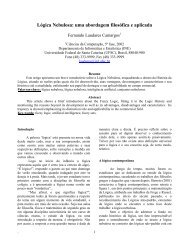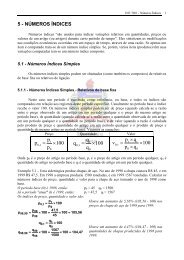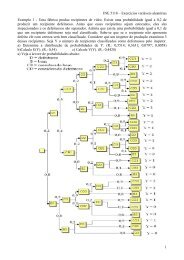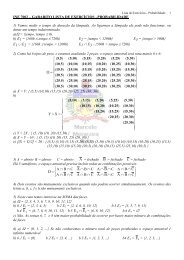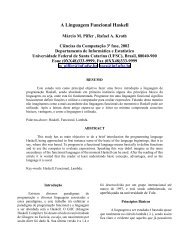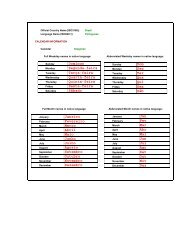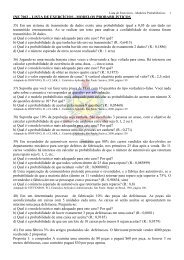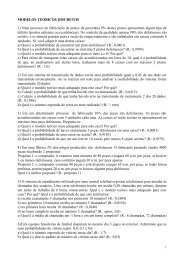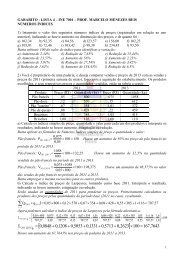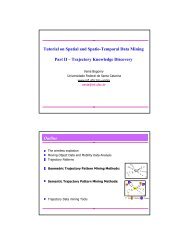Anais do IHC'2001 - Departamento de Informática e Estatística - UFSC
Anais do IHC'2001 - Departamento de Informática e Estatística - UFSC
Anais do IHC'2001 - Departamento de Informática e Estatística - UFSC
Create successful ePaper yourself
Turn your PDF publications into a flip-book with our unique Google optimized e-Paper software.
62<br />
<strong>Anais</strong> <strong>do</strong> IHC’2001 - IV Workshop sobre Fatores Humanos em Sistemas Computacionais<br />
organisations can be thought of as “groups of groups” [10], as the dynamic processes<br />
<strong>de</strong>fining relationships among the groups are important factors in the promotion of the<br />
established goals.<br />
Even though the organisation as a whole may have a single clear set of goals and interests,<br />
individuals and groups within the organisation may not share these goals and interests in<br />
the same way. For instance, in a software <strong>de</strong>velopment organisation, members of the<br />
Usability Engineering team may differ substantially from members of the Development<br />
team in terms of their background and work practice. To most software engineers, the<br />
system is thought of in terms of its structure, functions, and components. To a usability<br />
engineer, the system inclu<strong>de</strong>s the human user and all his potential actions interacting with<br />
the software. In addition, there are different performance parameters for different groups<br />
insi<strong>de</strong> the organisation. While the software <strong>de</strong>velopers have their concern on <strong>de</strong>velopment<br />
schedules and correction of co<strong>de</strong>, the usability engineers have the preoccupation of<br />
insuring usability without causing <strong>de</strong>lay in the process. A kind of tension between groups<br />
is not rare. In addition, within organisations, work groups can be influenced by the<br />
different cultures revealed through their assumptions, beliefs, self-image, feelings and<br />
fears, and the language they use to talk about their daily work [3], [10].<br />
A comprehensive and integrated un<strong>de</strong>rstanding of the connections among <strong>de</strong>sign and<br />
<strong>de</strong>velopment activities is necessary at all levels of the process. Un<strong>de</strong>rstanding and<br />
integrating the whole <strong>de</strong>velopment process requires an un<strong>de</strong>rstanding of how different<br />
groups in the organisation acquire and communicate this overview. As pointed out by Hix<br />
and Hartson [11] this seems to be true in any large system (e.g. a new automobile <strong>de</strong>sign).<br />
Participatory [15] and Contextual Design [3] propose several techniques as communication<br />
mechanisms in or<strong>de</strong>r to bring a <strong>de</strong>sign team to a shared un<strong>de</strong>rstanding of the customer.<br />
While we recognise the efforts of some metho<strong>do</strong>logies for a shared un<strong>de</strong>rstanding of the<br />
subject of <strong>de</strong>sign, we argue that a global view of the communication among the different<br />
groups in the organisation is important to ensure quality in the process and in the product,<br />
as a consequence. As a responsibility of the whole project, not of individual initiatives,<br />
new communication requirements emerge in the <strong>de</strong>sign and <strong>de</strong>velopment process.<br />
Semiotics allows us to un<strong>de</strong>rstand information and communication aspects involved in<br />
organisations. Liu [13 p.7] points to “a set of methods that can be used by researchers and<br />
business users in their un<strong>de</strong>rstanding, <strong>de</strong>velopment, management and use of information<br />
systems”. Our focus in this work is on un<strong>de</strong>rstanding the communication process that takes<br />
place between groups in a software <strong>de</strong>sign organisation, the nature of the changed<br />
messages in relation to their meaning for the audience, and how they impact and are<br />
propagated in the whole process. We based our un<strong>de</strong>rstanding of communication on<br />
Semiotic foundations, to propose a meta-mo<strong>de</strong>l for analysing the whole process of system<br />
<strong>de</strong>sign and <strong>de</strong>velopment. A case study with the process of a large software organisation<br />
illustrated our proposal.<br />
The paper is organised as follows: Section 2 presents the theoretical rationale for our<br />
un<strong>de</strong>rstanding of communication in the <strong>de</strong>sign process. Section 3 presents a case study to<br />
highlight some results of representing communication involved in a product <strong>de</strong>velopment<br />
cycle and walking-through the proposed meta-mo<strong>de</strong>l. Section 4 conclu<strong>de</strong>s pointing out to<br />
further work.



